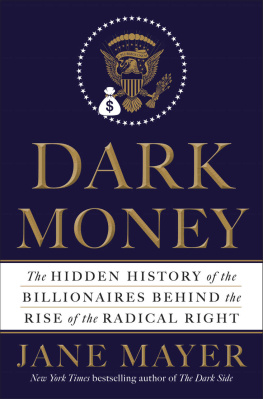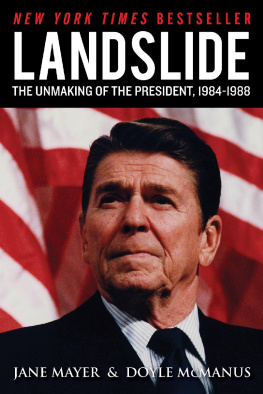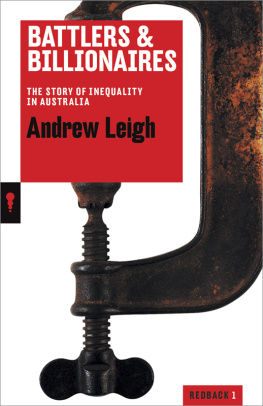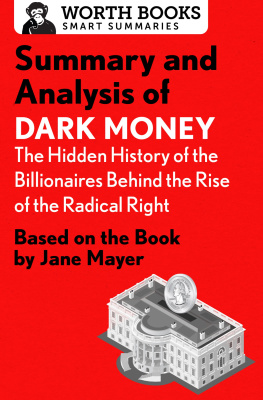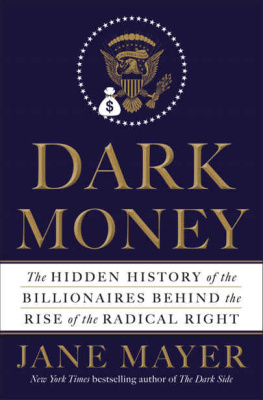Jane Mayer - Dark Money: The Hidden History of the Billionaires Behind the Rise of the Radical Right
Here you can read online Jane Mayer - Dark Money: The Hidden History of the Billionaires Behind the Rise of the Radical Right full text of the book (entire story) in english for free. Download pdf and epub, get meaning, cover and reviews about this ebook. year: 2016, publisher: Knopf Doubleday Publishing Group, genre: Politics. Description of the work, (preface) as well as reviews are available. Best literature library LitArk.com created for fans of good reading and offers a wide selection of genres:
Romance novel
Science fiction
Adventure
Detective
Science
History
Home and family
Prose
Art
Politics
Computer
Non-fiction
Religion
Business
Children
Humor
Choose a favorite category and find really read worthwhile books. Enjoy immersion in the world of imagination, feel the emotions of the characters or learn something new for yourself, make an fascinating discovery.
- Book:Dark Money: The Hidden History of the Billionaires Behind the Rise of the Radical Right
- Author:
- Publisher:Knopf Doubleday Publishing Group
- Genre:
- Year:2016
- Rating:5 / 5
- Favourites:Add to favourites
- Your mark:
Dark Money: The Hidden History of the Billionaires Behind the Rise of the Radical Right: summary, description and annotation
We offer to read an annotation, description, summary or preface (depends on what the author of the book "Dark Money: The Hidden History of the Billionaires Behind the Rise of the Radical Right" wrote himself). If you haven't found the necessary information about the book — write in the comments, we will try to find it.
The hidden history of the billionaires behind the rise of the radical right. Read more...
Abstract: Why is America living in an age of profound economic inequality? Why, despite the desperate need to address climate change, have even modest environmental efforts been defeated again and again? Why have protections for employees been decimated? Why do hedge-fund billionaires pay a far lower tax rate than middle-class workers? The conventional answer is that a popular uprising against big government led to the ascendancy of a broad-based conservative movement. But Jane Mayer argues that a network of exceedingly wealthy people with extreme libertarian views bankrolled a systematic, step-by-step plan to fundamentally alter the American political system. Their core beliefs -- that taxes are a form of tyranny; that government oversight of business is an assault on freedom -- are sincerely held. But these beliefs also advance their personal and corporate interests: Many of their companies have run afoul of federal pollution, worker safety, securities, and tax laws. The chief figures in the network are Charles and David Koch. The brothers were schooled in a political philosophy that asserted the only role of government is to provide security and to enforce property rights. When libertarian ideas proved decidedly unpopular with voters, the Koch brothers and their allies chose another path. If they pooled their vast resources, they could fund an interlocking array of organizations that could work in tandem to influence and ultimately control academic institutions, think tanks, the courts, statehouses, Congress, and, they hoped, the presidency. These organizations were given innocuous names such as Americans for Prosperity. Funding sources were hidden whenever possible. This process reached its apotheosis with the allegedly populist Tea Party movement, abetted mightily by the Citizens United decision -- a case conceived of by legal advocates funded by the network. And their efforts have been remarkably successful. Libertarian views on taxes and regulation, once far outside the mainstream and still rejected by most Americans, are ascendant in the majority of state governments, the Supreme Court, and Congress. Meaningful environmental, labor, finance, and tax reforms have been stymied. Jane Mayer spent five years conducting hundreds of interviews -- including with several sources within the network -- and scoured public records, private papers, and court proceedings to trace the byzantine trail of the billions of dollars spent and to provide vivid portraits of the colorful figures behind the new American oligarchy.
The hidden history of the billionaires behind the rise of the radical right
Jane Mayer: author's other books
Who wrote Dark Money: The Hidden History of the Billionaires Behind the Rise of the Radical Right? Find out the surname, the name of the author of the book and a list of all author's works by series.

